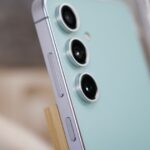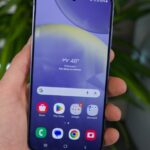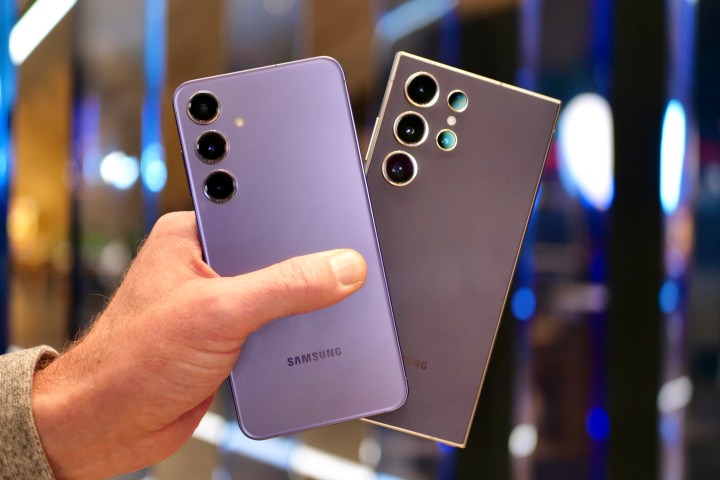
Samsung is one of the most recognizable names in modern smartphones. It has a well-deserved reputation for offering an expansive lineup of great phones with something for just about everyone. This means if you’re looking for an Android phone, you’ll easily find a Samsung model that’s worth considering based on your needs and budget. In fact, the number of choices can be a bit overwhelming, but the good news is that we’ve explored the entire range and highlighted the best Samsung smartphones you can buy in 2024.
The Samsung Galaxy S24 Plus gets the nod for the best overall Samsung phone, and while it’s odd it’s not the ultra-premium S24 Ultra that takes the prize, that’s because Samsung has outdone itself this time around with the Plus model. The big phone has the same power, display, and Galaxy AI features as its larger sibling, with only a few small downsides that are easily balanced out by the $300 price difference. But if this year’s Plus doesn’t tickle your fancy, we have so many other great Samsung smartphones that one is sure to be perfect for you.

Samsung Galaxy S24 Plus
The best Samsung phone overall
Pros
- The flat sides are wonderful
- New QHD+ screen looks fantastic
- Runs fast and cool
- One UI 6.1 is really nice
- Seven years of updates
- Phenomenal battery life
- It’s a surprisingly good value
Cons
- Camera struggles with moving objects
- Galaxy AI features are hit-or-miss
Why you should buy this: It’s a surprise contender for the best phone of the year.
Who it’s for: Anyone who wants the best Samsung phone around, pound-for-pound.
Why we picked the Samsung Galaxy S24 Plus:
So, this was definitely a surprise. We were all set to crown the Galaxy S24 Ultra as this year’s best Samsung phone, but then the Samsung Galaxy S24 Plus came steaming into our lives. While you may expect the Plus entry to be the awkward middle child, 2024’s S24 Plus is simply one of the best phones you can buy, with a sublime design, powerful processor, phenomenal battery life, and gorgeous display.
Samsung has made some big tweaks to last year’s already great formula, and that’s the root of this year’s success. The most obvious changes are those made to the phone’s design. The S24 Plus’ flat sides have made the phone more comfortable to hold, added grip, and don’t pick up fingerprints. Samsung has also upgraded the phone’s display, and the 120Hz dynamic refresh rate now goes down to 1Hz, boosting battery life. It’s also brighter than before, and is capable of going up to 2,600 nits. The resolution has been upgraded too, going up to 1440p now.
Performance is as great as ever, thanks to the Qualcomm Snapdragon 8 Gen 3. Qualcomm’s flagship CPUs are as fast as ever, and are even a noticeable improvement over last year’s chip, giving the S24 Plus stupendously fast processing speeds. It doesn’t get hot, even when running punishing games like CoD: Mobile, and it’s also partly responsible for the Samsung Galaxy S24 Plus’ incredible battery life.
We’re used to flagship phones lasting about a day on a full charge, but the S24 Plus blows straight past it. After a demanding day with over four hours of screen time, the S24 Plus went to bed with 38% still in the tank. A more reasonable day saw it advance pretty happily into the second day, even with almost three hours of screen time. Pair this lengthy battery life with 45W fast charging, and you’ve got a phone that won’t spend a lot of time on the charger.
The big new addition this year is Galaxy AI, and while these features are interesting, they’re certainly not a reason to buy into the newest generation of Galaxy flagships. Many of them mirror similar AI-powered features on the Google Pixel 8 Pro, like the Magic Editor-like Generative Edit, and the Live Translate function. The message suggestions are just hilariously bad, with the offered changes coming out somewhere between an awkward robot and a flirty Mr Darcy.
The camera is one of the weakest parts of the phone, which is a big compliment to the phone as a whole, as it’s still very good. A 50-megapixel main camera joins a 12MP wide-angle camera and a 10MP telephoto with a 3x optical zoom, and it’s a great combination. Samsung seems to have tamed its saturation filters, so stills come out very well. But “stills” has never been more literal a description, as the camera really struggles with even the smallest amount of movement.
That fairly common issue being the most serious negative to a phone tells you everything you need to know: The Samsung Galaxy S24 Plus really is an excellent piece of technology, and the best overall Samsung smartphone. With prices starting from $1,000, it’s not as bank-breaking as the S24 Ultra, but offers the same level of high performance, and close to the same level of premium features.

Samsung Galaxy S24 Plus
The best Samsung phone overall

Samsung Galaxy S24 Ultra
The best premium Samsung phone
Pros
- High performance processor
- Improved telephoto cameras
- Flatter screen aids S Pen use
- Battery will last two days
- Long software support
- Durable build and materials
- Circle to Search by Google
Cons
- Unfortunate price increase
- Speakers easily covered up
- Chat Assist is almost unusable
- Charging speeds are only average
Why you should buy this: It’s the pinnacle of Samsung’s smartphone creation.
Who it’s for: Someone who wants the most impressive Samsung smartphone, regardless of cost.
Why we picked the Samsung Galaxy S24 Ultra:
The S24 Plus may top this list, but there’s no way we’re going to leave the Samsung Galaxy S24 Ultra out. The Ultra is something of a testing ground for new features, and that makes the Ultra the biggest and most technologically advanced smartphone Samsung offers — even if that means it comes at a high price.
Like the Plus above, the S24 Ultra has had a few small design tweaks, but it’s still largely the same phone as last year. The Armor Aluminum frame has been replaced with titanium, and the sides and screen have been flattened slightly, making it easier to handle and use the S Pen on. It’s still a beast of a device, though — a real pocket-stretcher that you’ll need hefty forearms to use for a long period of time.
The screen’s peak brightness is now set at 2,600 nits, making it exceptionally bright. Not that the 6.8-inch display is hard to see, as the Dynamic AMOLED 2X tech means it’s bright and vivid, with some of the deepest inky blacks you can find on a smartphone. A 1440p resolution is available (though you have to change to it manually), and the dynamic refresh rate means your experience is buttery smooth when it needs to be, but not when it doesn’t. As with the S24 Plus above, performance is extremely swift thanks to the Snapdragon 8 Gen 3. It’s joined by 12GB of RAM and 256GB of storage as standard.
The camera system seems to have had a downgrade this year, dropping from a 10x optical zoom to 5x, but it’s actually better because of the change. Since a 5x zoom is actually a zoom level most people use, it’s a much better inclusion on the whole. The entire system comprises a 200MP main camera, a 12MP wide-angle camera, 10MP telephoto camera with a 3x optical zoom, and the aforementioned 50MP telephoto lens with a 5x zoom. It’s as excellent a camera system as you’d expect. Galaxy AI is here too, and it’s about as useful as it is in the S24 Plus — i.e., don’t expect too much of it.
There’s a 5,000mAh battery inside the massive frame, and it’s extremely long-lasting. During our time with it, it would regularly achieve five hours of screen time, and end the day with 50% remaining. You’ll have to use it for around a week for the phone to adapt to your usage, but once it has, it’ll deliver some excellent power efficiency. Charging times are good, with 45W fast charging available. It’s not the fastest charging available, but it’s also far from the slowest.
The Samsung Galaxy S24 Ultra is the most expensive phone in Samsung’s S-range lineup, but it’s also the most premium one you’ll find outside of foldable phones. As such, it has a price tag to match. The Galaxy S24 Ultra will set you back $1,300, and that’s before you expand your storage at all. On the plus side, you get an S Pen, which is kept inside the phone, but it’s still an expensive phone to buy. But if you want the best, this is it.

Samsung Galaxy S24 Ultra
The best premium Samsung phone

Samsung Galaxy S24
The best small Samsung phone
Pros
- Small and compact design
- The flat edges are great
- Beautiful and bright display
- Long lasting battery life
- Powerful performance
- Improved color balance in photos
- Useful Galaxy AI features
Cons
- Matte glass feels slippery
- No big camera upgrades
- Only 25W wired charging
Why you should buy this: It’s everything amazing about Samsung’s phones, but smaller.
Who it’s for: Someone who wants a more compact smartphone, but doesn’t want to compromise on performance.
Why we picked the Samsung Galaxy S24:
We can keep this one a little briefer than the other entries because a lot of what makes the Samsung Galaxy S24 great is also what makes the S24 Plus great. Well, except for one thing, of course — and that’s that the S24 is downright svelte when compared to its siblings.
It benefits from the same flat sides as the S24 Plus, with the added bonus that the body itself is even smaller, so even easier to handle. The 6.2-inch display uses LTPO tech in the Dynamic AMOLED 2X display, meaning it should be more power efficient than ever before, especially with an always-on display. Unlike the other entries in the range, though, it tops out at a 1080p resolution. However, it still has a 1-120Hz dynamic refresh rate and a peak brightness of 2,600 nits, so it’s easy enough to forgive the lower resolution.
It has the same Snapdragon 8 Gen 3 you’ll find in the two larger phones, so performance is just as good, and it also contains the new Galaxy AI. Once again, try these out, play with them a little bit, but don’t expect them to transform your smartphone experience forever. It’s just not there yet.
The camera system uses the same three lenses as the S24 Plus, and a lot of our criticisms of that phone apply to this one, too, with the additional downside that low-light photos can be a little bit underwhelming. But, still photographs look great, and Samsung has fixed its oversaturation problem, meaning photos no longer have an over-the-top color pop that’s just not realistic.
Charging speeds are lower than the S24 Plus and S24 Ultra, though, being limited to 25W. Thankfully, the battery is similarly good, with a solid day’s use from one charge.
Ultimately, a lot about this phone is very similar to the S24 Plus, with the exception of the size and the price. It’s the Samsung flagship to grab if a compact phone is a must, as the small size really doesn’t mean compromises have been made. Rather, it’s just as powerful, good-looking, and technically impressive as its larger siblings, and it’s a steal at $800.

Samsung Galaxy S24
The best small Samsung phone

Samsung Galaxy Z Fold 6
The best foldable Samsung phone
Pros
- Fantastic folding design
- Refined size and weight
- IP48 water and dust resistance
- Two colorful, usable screens
- Main camera takes fun, vibrant photos
- Long software commitment
Cons
- Slow battery charging
- One-day battery life
- More expensive than last year
Why you should buy this: The Galaxy Z Fold 6 is a productivity buff’s dream, with its dual display, up to 1TB of storage, and robust, yet light Armor Aluminum frame.
Who it’s for: Anybody who wants a productivity punch and top-notch specs bundled into a foldable format.
Why we picked the Samsung Galaxy Z Fold 6:
The Galaxy Z Fold 6 is the best Samsung phone for productivity, with a foldable form factor and dual screens. Its front display measures 6.3 inches, just slightly larger than the Z Fold 5. Once you open it up, you get the full 7.6-inch main display with the series’ most seamless crease yet. Both screens reach up to a 120Hz refresh rate, too. You almost forget you’re using a smartphone instead of a mini tablet.
The Armor Aluminum frame and Gorilla Glass Victus 2 on the cover screen and back enhance durability while maintaining a sleek, comfortable hold. The IP48 rating also adds an additional layer of protection from dust and water. You can also add a special case for the S Pen, which you need to buy separately, but works wonderfully if you want to use the Z Fold 6 as a notepad.
The Z Fold 6 upgrades its processor to the Snapdragon 8 Gen 3, which provides a light performance boost and powers Samsung’s Galaxy AI. Many of its specs like its 12GB of RAM and up to 1TB of storage transfer over from the past generation. Meanwhile, AI now assists with tasks from translations to note-taking and shows up as generative AI in the camera and photo-editing apps. Speaking of which, the Z Fold 6 features the same 50MP main camera, a 12MP wide-angle lens, 10MP telephoto lens with 3x optical zoom, and 4MP Under Display Camera as its predecessor. It’s not a camera system that’ll dethrone the Galaxy S24 Ultra’s, but it’s still very, very good.
The Z Fold 6’s productivity is a double-edged sword. While it can juggle demanding tasks and seamlessly process them on a bright, foldable screen, those processes take a toll on its 4,400mAh battery. Two and a half hours of everyday usage already saps the energy down to 50%, even without playing games. It isn’t much of a problem, though, if you have portable batteries or alternative ways to charge while you’re outside of the house. It supports 25W wired charging and 15W wireless charging, but no charger in the box.
Samsung is set to support the Z Fold 6 with at least seven years of Android OS and security updates. The device runs on Android 14 OS with Samsung’s One UI 6.1.1, including the improved Taskbar that now displays up to four recent apps instead of two. The Taskbar is particularly useful for multitasking on the Z Fold 6, allowing users to drag apps onto the main screen. You can use up to three apps on the unfolded screen and add a fourth app as a floating window. You can also easily alter the shape and size of each app window and activate multitasking.
If you already have the Z Fold 5, it’s hard to recommend upgrading to a phone that’s almost the same. However, if you’re new to the foldable phone world, it offers plenty of pros as a smartphone that can basically double as a tablet.

Samsung Galaxy Z Fold 6
The best foldable Samsung phone

Samsung Galaxy Z Flip 6
The best Samsung flip phone
Pros
- Top-notch hardware
- IP48 dust and water resistance
- Very good inner display
- Fast, snappy performance
- New 50MP camera is great
- Seven years of updates
Cons
- Bad cover screen
- Slow charge speeds
- Frustrating price increase
- Extremely similar to the Flip 5
Why you should buy this: If you can afford a folding phone that costs over $1,000 right now, the Samsung Galaxy Z Flip 6 is the one you should buy.
Who it’s for: Those who simply must have the latest and most popular foldable.
Why we picked the Samsung Galaxy Z Flip 6:
There are several reasons why tech enthusiasts are buzzing about Samsung’s latest folding phone, the Galaxy Z Flip 6. For starters, it boasts an improved camera, a sturdier hinge construction, a newer and faster processor, and extended software support. On top of that, it features an overall sleek and elegant build that’s sure to turn heads. The Z Flip 6 offers a diverse palette of colors, including yellow, mint, blue, gray, peach, white, and “crafted black” — a black, textured colorway that makes monotone cool again.
When you flip the phone open, you’ll see the 6.7-inch AMOLED 2X display and its bright, pixel-perfect 2640 x 1080 screen. Its 2,600 nits of brightness can outshine daytime glare and the 120Hz refresh rate with VRR seamlessly plays videos and games. The cover screen is a 3.4-inch Super AMOLED that’s much more useful than previous models — it even allows you to run full Android apps. It almost makes up for the fact that its sluggish 60Hz refresh rate and fuzzy 720×748 resolution demystify the magic a bit.
The Galaxy Z Flip 6 upgrades to the Snapdragon Gen 3, the new standard in Samsung phones. However, that’s not the biggest improvement in this model. The Z Flip 6 ramps up the RAM to 12GB (the Galaxy Z Flip 5 had 8GB) and offers up 512GB of storage. Finally, it has the same amount of processing power as its larger foldable cousin, the Galaxy Z Fold 6. It also boasts the privilege of being the first Z Flip phone with a vapor chamber 50% larger than that in the S23 Ultra. As a result, it’s cool to touch, even under stress.
The Galaxy Z Flip 6 has a 4,000mAh battery, which is technically more than the Z Flip 5 but still isn’t enough to call it a two-day flip phone. If you’re fine with charging overnight, you’ll have more than enough juice to make it through an early morning to a late evening. It offers multiple charging options, including 25W wired charging, 15W wireless (including MagSafe), and 4.5W reverse wireless charging. It’s serviceable, but still the same as the Z Flip 5.
The 12MP ultrawide camera with a 123-degree field of view and 10 MP selfie camera on the Z Flip 6 match the specs on its predecessor. However, it does make a significant jump to its 50MP main camera from the 12MP on the Z Flip 5. It’s the same camera used in Galaxy S24 and S24 Plus phones, hailed as some of today’s best camera phones.
Other than that, it’s basically identical to last year’s model. To Samsung’s credit, the Z Flip 6 does feature upgrades to its cameras. The Snapdragon 8 Gen 2’s improved image signal processor provides better color reproduction, while the main and ultrawide cameras have a new “clear lens coating” to prevent lens flares. Its Android 14 OS and Samsung’s One UI 6.1.1 support are a strong start to its seven years of updates.

Samsung Galaxy Z Flip 6
The best Samsung flip phone
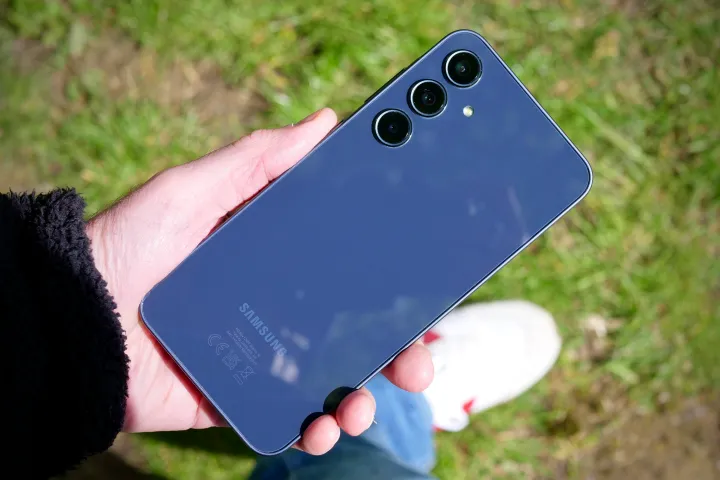
Samsung Galaxy A35
The best value Samsung phone
Pros
- Light and comfortable to hold
- IP67 rating makes it durable
- Main camera takes fun photos
- Long software update commitment
Cons
- Battery doesn’t last two days
- No wireless or fast charging
Why you should buy this: It costs significantly less than the Galaxy S24 while still delivering a lovely display, decent cameras, and good performance.
Who it’s for: Anybody who wants a dependable smartphone for under $500.
Why we picked the Samsung Galaxy A35:
Samsung’s Galaxy S24 series is outstanding, as are its folding phones. But the truth is that a lot of people can’t afford those expensive handsets — and that’s why the Galaxy A35 is so important. You get many of the same features found on Samsung’s more expensive phones at a fraction of the price.
For starters, the Galaxy A35 still looks like its pricier Galaxy counterparts, even though its frame is made from plastic instead of aluminum. It only weighs 209g and measures 8.2mm thick, so it’s light and comfortable to hold and thin enough to slip into the average pocket. The IP67 rating also safeguards it from dust and water, though you shouldn’t take it for a dip at the pool anytime soon. It still features Gorilla Glass Victus over the front, but it has regular glass on the rear. I wouldn’t drop the phone on purpose to test the difference, but at least one side still benefits from the higher-quality material.
The Galaxy A35 sports a slightly larger screen than its predecessor, the Galaxy A34. The 6.6-inch Super AMOLED display delivers crisp text and strong, vibrant colors and reaches up to 1,000 nits of brightness with 2340×1080 resolution. Even more impressive is the 120Hz refresh rate that enables everything to feel fast and smooth. It’s mostly thanks to the Exynos 1380 processor and 8GB of RAM. The Galaxy A35 isn’t the fastest phone you’ll ever use, but it’s more than capable for anything you’d want to throw at it.
Despite the price, the Galaxy A35 also features a respectable 5,000mAh battery. One 30-minute YouTube video eats about 6% of battery life. Based on that, the battery can last over eight hours with just everyday use. It supports the USB Power Delivery 3.0 standard of 25W wired charging, which can take it from “flat to full” in 1 hour and 25 minutes or up to 50% in 40 minutes. Unfortunately, it doesn’t support wireless charging or fast charging.
What about the cameras? Well, the 50MP main camera isn’t the best we’ve ever seen, but for quick and casual photography, it gets the job done. It also tends to produce very bright and overly saturated photos, more so than its S24 cousins. It also has an 8MP wide-angle camera and fixed focus 5MP macro camera on the back, and a 13MP selfie camera is on the front. These cameras don’t take nearly as detailed photos as the main one, but they still take respectable photos when used with their strengths in mind. As a plus, the editing suite in the Gallery app is easy to use.
Does that mean pictures look lifelike and 1:1 accurate to the real world? Not exactly. But if you prefer your photos to have a real punch to them, the Galaxy A35 certainly delivers.
If you have more money to burn, a phone like the Galaxy S24 or Galaxy S24 Plus is going to deliver a better experience in every department. However, if $400 is the most you can spend, you’ll find very little to be disappointed about with the Galaxy A35.

Samsung Galaxy A35
The best value Samsung phone
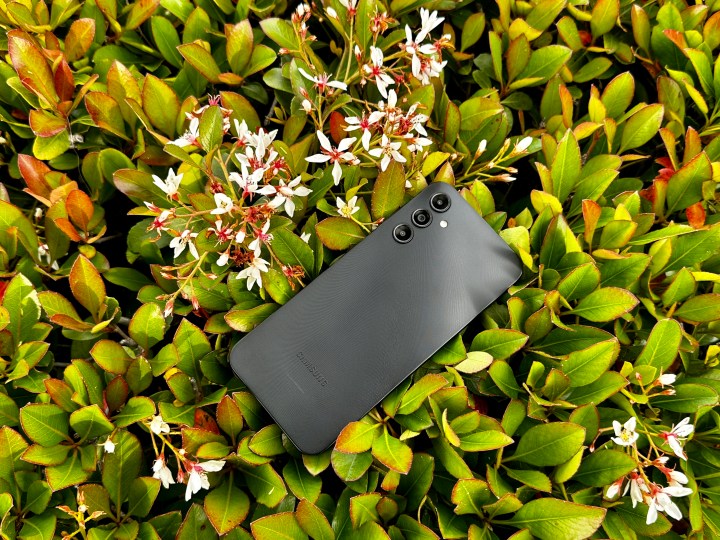
Samsung Galaxy A14 5G
The best cheap Samsung phone
Pros
- Only $200
- Large display with a 90Hz refresh rate
- 5,000mAh battery
- 50MP rear camera, 13MP selfie camera
- Respectable performance
- Unique, textured back
Cons
- Secondary cameras aren’t impressive
- No water or dust resistance
- Fast charging up to 15W only
Why you should buy this: It has no business being this good when it costs just $200.
Who it’s for: Anyone looking for a Samsung phone that doesn’t break the bank but still performs very well.
Why we picked the Samsung Galaxy A14 5G:
The $200 phone market is usually where you’ll find phones full of compromises. A low price often means harsh cost-cutting, and as a result, you’re unlikely to find something that can be described as “good”. That’s not the case with the Samsung Galaxy A14 5G, which is a true diamond in the rough.
You’ll struggle to define the A14 as a stunner, but it’s not a bad-looking smartphone. The body is made from plastic, but it has a unique texture that feels good and adds grip, something glass-bodied phones can struggle with. The display is worth pausing over, though. It’s a 6.6-inch LCD with a 1080p resolution, which isn’t bad by itself — but the inclusion of a 120Hz refresh rate definitely pushes this phone into a higher grade. There isn’t any water resistance, but hey, you can’t have everything, especially at this price.
It’s modestly powered by a MediaTek Dimensity 700 processor, the same chip from the A13. We found it stuttered a little during use, which reduced the smoothness of the 120Hz refresh rate, and it was sometimes sluggish to open apps, so make sure to clear out those running apps once in a while to keep it speedy. Storage starts from 64GB, which is relatively low these days, but there’s the option to use a microSD card to expand that by 1TB. It comes with Android 13, and Samsung has committed to two major Android updates and four years of security updates — a strong promise for a budget smartphone.
The main camera is impressive for a $200 smartphone. The main lens has a 50MP sensor, and it consistently took good, crisp images that are more than good enough for social media. Surprisingly for a cheap phone, it even takes clear night mode shots too. The second lens, a 2MP depth sensor, is there to assist the main camera in portrait shots, so it’s really technically a dual-lens system. Unfortunately, the third lens, a 2MP macro lens, continues the strong tradition of macro lenses being a bit rubbish, and it’s not one to rely on at all. Stick with the 50MP main lens instead, you’ll probably be pleasantly surprised by how good your shots are for a $200 smartphone.
The A14 has a 5,000mAh battery, and it’s capable of going for two days on a single charge. That’s helpful, as the charging rate is limited to 15W, so you’ll be wanting to leave it for a little while when charging. There’s no wireless charging, which makes sense on a phone this cheap.
The Samsung Galaxy A14 5G is available now, with prices starting from $200. As always, keep an eye on the sales, and you could snag this excellent phone for even cheaper. It’s available on all major U.S. carriers, though the U.S. only gets the rather boring plain black color.

Samsung Galaxy A14 5G
The best cheap Samsung phone
Read the full article here





